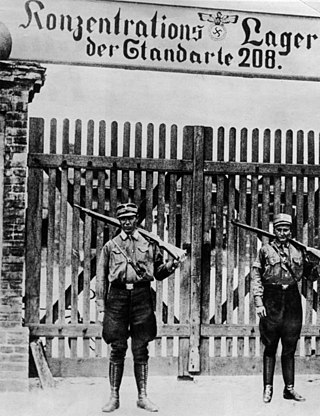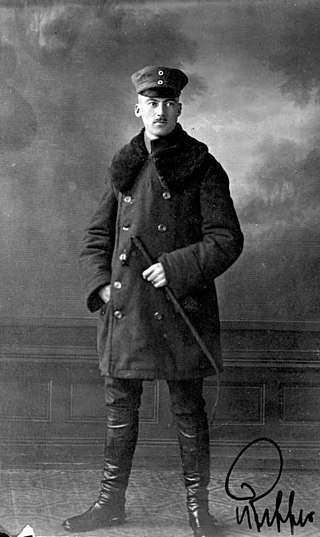
The Nazi Party, officially the National Socialist German Workers' Party, was a far-right political party in Germany active between 1920 and 1945 that created and supported the ideology of Nazism. Its precursor, the German Workers' Party, existed from 1919 to 1920. The Nazi Party emerged from the extremist German nationalist, racist and populist Freikorps paramilitary culture, which fought against communist uprisings in post–World War I Germany. The party was created to draw workers away from communism and into völkisch nationalism. Initially, Nazi political strategy focused on anti–big business, anti-bourgeois, and anti-capitalist rhetoric; it was later downplayed to gain the support of business leaders. By the 1930s, the party's main focus shifted to antisemitic and anti-Marxist themes. The party had little popular support until the Great Depression, when worsening living standards and widespread unemployment drove Germans into political extremism.

The Night of the Long Knives, also called the Röhm purge or Operation Hummingbird, was a purge that took place in Nazi Germany from 30 June to 2 July 1934. Chancellor Adolf Hitler, urged on by Hermann Göring and Heinrich Himmler, ordered a series of political extrajudicial executions intended to consolidate his power and alleviate the concerns of the German military about the role of Ernst Röhm and the Sturmabteilung (SA), the Nazis' paramilitary organization, known colloquially as "Brownshirts". Nazi propaganda presented the murders as a preventive measure against an alleged imminent coup by the SA under Röhm – the so-called Röhm Putsch.
The Sturmabteilung was the original paramilitary wing of the Nazi Party. It played a significant role in Adolf Hitler's rise to power in the 1920s and 1930s. Its primary purposes were providing protection for Nazi rallies and assemblies, disrupting the meetings of opposing parties, fighting against the paramilitary units of the opposing parties, especially the Roter Frontkämpferbund of the Communist Party of Germany (KPD) and the Reichsbanner Schwarz-Rot-Gold of the Social Democratic Party of Germany (SPD), and intimidating Romani, trade unionists, and especially Jews.

Ernst Julius Günther Röhm was a German military officer and a leading member of the Nazi Party. Initially a close friend and early ally of Adolf Hitler, Röhm was the co-founder and leader of the Sturmabteilung (SA), the Nazi Party's original paramilitary wing, which played a significant role in Adolf Hitler's rise to power. He served as chief of the SA from 1931 until his murder in 1934 during the Night of the Long Knives.

Gregor Strasser was a German politician and early leader of the Nazi Party. Along with his younger brother Otto, he was a leading member of the party's left-wing faction, which brought them into conflict with the dominant faction led by Adolf Hitler, resulting in his murder in 1934. The brothers' strand of the Nazi ideology is known as Strasserism.

Horst Ludwig Georg Erich Wessel was a member of the Sturmabteilung (SA), the paramilitary wing of the Nazi Party, who became a propaganda symbol in Nazi Germany following his murder in 1930 by two members of the Communist Party of Germany (KPD). After his death Joseph Goebbels turned him into a martyr for the Nazi Party.

Strasserism is an ideological strand of Nazism which adheres to revolutionary nationalism and to economic antisemitism, which conditions are to be achieved with radical, mass-action and worker-based politics that are more aggressive than the politics of the Hitlerite leaders of the Nazi Party. Named after Gregor Strasser and Otto Strasser, the ideology of Strasserism is a type of Third Position, right-wing politics in opposition to Communism and to Hitlerite Nazism.

Obergruppenführer was a paramilitary rank in Nazi Germany that was first created in 1932 as a rank of the Sturmabteilung (SA) and adopted by the Schutzstaffel (SS) one year later. Until April 1942, it was the highest commissioned SS rank after only Reichsführer-SS. Translated as "senior group leader", the rank of Obergruppenführer was senior to Gruppenführer. A similarly named rank of Untergruppenführer existed in the SA from 1929 to 1930 and as a title until 1933. In April 1942, the new rank of SS-Oberst-Gruppenführer was created which was above Obergruppenführer and below Reichsführer-SS.
The early timeline of Nazism begins with its origins and continues until Hitler's rise to power.

The uniforms and insignia of the Sturmabteilung (SA) were Nazi Party paramilitary ranks and uniforms used by SA stormtroopers from 1921 until the fall of Nazi Germany in 1945. The titles and phrases used by the SA were the basis for paramilitary titles used by several other Nazi paramilitary groups, among them the Schutzstaffel (SS). Early SS ranks were identical to the SA, since the SS was originally considered a sub-organisation of the Sturmabteilung.

Federal elections were held in Germany on 5 March 1933, after the Nazi seizure of power on 30 January 1933 and just six days after the Reichstag fire. The election saw Nazi stormtroopers unleash a widespread campaign of violence against the Communist Party (KPD), left-wingers, trade unionists, the Social Democratic Party, and the Centre Party. They were the last multi-party elections in a united Germany until 1990.

Franz Pfeffer von Salomon during the Nazi regime known as Franz von Pfeffer, was the first Supreme Leader of the Sturmabteilung (SA) after its re-establishment in 1925. Pfeffer resigned from his SA command in 1930 and was expelled from the Nazi Party in 1941. He died in 1968.

Adolf Hitler's rise to power began in the newly established Weimar Republic in September 1919 when Hitler joined the Deutsche Arbeiterpartei. He rose to a place of prominence in the early years of the party. Being one of its most popular speakers, he was made the party leader after he threatened to otherwise leave.

The Stennes revolt was a revolt within the Nazi Party in 1930 through 1931 led by Walter Stennes, the Berlin commandant of the Sturmabteilung (SA), the Nazi's "brownshirt" storm troops. The revolt arose from internal tensions and conflicts within the Nazi Party of Germany, particularly between the party organization headquartered in Munich and Adolf Hitler on the one hand, and the SA and its leadership on the other hand. There is some evidence suggesting that Stennes may have been paid by the government of German chancellor Heinrich Brüning, with the intention of causing conflict within and destabilizing the Nazi movement.

Walter Franz Maria Stennes was a leader of the Sturmabteilung of the Nazi Party in Berlin and the surrounding area. In August 1930 he led a revolt against Adolf Hitler, the leader of the party, and Hitler's appointed regional head of the party in the Berlin area, Joseph Goebbels. The dispute was over Hitler's policies and practices in the use of the SA, and the underlying purpose of the paramilitary organization. Hitler quelled the revolt peacefully, but after a second rebellion in March–April 1931, the SA was purged and Stennes was expelled from the party.

Prince Friedrich Christian of Schaumburg-Lippe was a German prince, the youngest son of Georg, Prince of Schaumburg-Lippe and his consort Princess Marie Anne of Saxe-Altenburg.
Nazism, the common name in English for National Socialism, is the far-right totalitarian socio-political ideology and practices associated with Adolf Hitler and the Nazi Party (NSDAP) in Germany. During Hitler's rise to power in 1930s Europe, it was frequently referred to as Hitlerism. The later related term "neo-Nazism" is applied to other far-right groups with similar ideas which formed after the Second World War when the Nazi regime collapsed.

Beginning in 1925, some members of higher levels of the German nobility joined the Nazi Party, registered by their title, date of birth, NSDAP Party registration number, and date of joining the Nazi Party, from the registration of their first prince (Ernst) into NSDAP in 1928, until the end of World War II in 1945.

The Röhm scandal resulted from the public disclosure of Nazi politician Ernst Röhm's homosexuality by anti-Nazis in 1931 and 1932. As a result of the scandal, Röhm became the first known homosexual politician.













